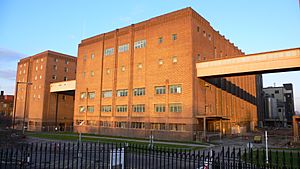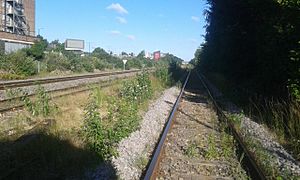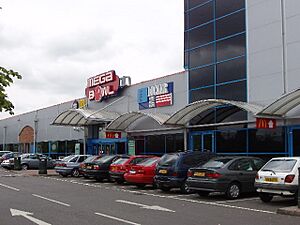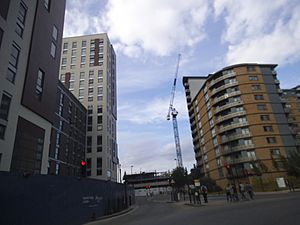Park Royal facts for kids
Quick facts for kids Park Royal |
|
|---|---|
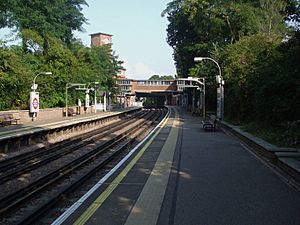 Park Royal station |
|
| OS grid reference | TQ195828 |
| London borough | |
| Ceremonial county | Greater London |
| Region | |
| Country | England |
| Sovereign state | United Kingdom |
| Post town | LONDON |
| Postcode district | NW10 |
| Postcode district | W3 |
| Dialling code | 020 |
| Police | Metropolitan |
| Fire | London |
| Ambulance | London |
| EU Parliament | London |
| UK Parliament |
|
| London Assembly |
|
Park Royal is an area in Northwest London, England. It is split between the London Borough of Ealing and the London Borough of Brent.
Park Royal is home to London's largest business park. Even though it's already busy, the area is set to become one of the UK's biggest redevelopment projects. This is because it's quite central and has great transport links. These links will soon include the HS2 train line and the Elizabeth line. Because of these big plans, some people call Park Royal and the nearby Old Oak area the "Canary Wharf of West London".
Contents
Exploring Park Royal's Location
Park Royal is surrounded by other parts of London. To the north, you'll find Harlesden and West Twyford. There's also a Network Rail depot at Stonebridge Park. This area also has London Underground Bakerloo line tracks.
On the eastern side, Park Royal is next to Acton Lane and Park Royal Road. The Central Middlesex Hospital is located here.
The Grand Union Canal flows right through the middle of the Park Royal business area. You can walk along its towpath.
A Look Back in Time: Park Royal's History
The name Park Royal comes from a special showground. The Royal Agricultural Society of England opened it in 1903. It was meant to be a permanent place for their yearly "Royal Show".
But after only three years, the society sold the land. They went back to holding their shows in different places each year. Because of its good connections by road, rail, and canal, Park Royal became an industrial area. Most of this development happened in the 1930s.
For many years, Park Royal was a hub for engineering companies. Famous firms like Park Royal Vehicles and GKN were based here.
The football club Queens Park Rangers F.C. played on two different grounds in Park Royal. Their first ground was called the Horse Ring. It could hold 40,000 fans. Later, the Guinness brewery was built on this site.
When the Royal Agricultural Society sold the land in 1907, QPR moved to the Park Royal Ground. This new ground was very similar to Ayresome Park. It could hold 60,000 people. The club had to leave in February 1915. The Army took over the ground.
On December 12, 1908, a historic rugby league match took place here. It was the first ever test match between Great Britain and Australia. About 2,000 fans watched the game, which ended in a 22-all draw.
The Guinness Sports Club also hosted some hockey events. This was during the 1948 Summer Olympics held in London.
Park Royal Today: Businesses and Big Plans
What's Here Now?
Park Royal is home to London's biggest business park. It covers about 1,200 acres (485 hectares). More than 1,200 businesses are located here. They employ an estimated 35,000 workers. Around 500 food companies operate in Park Royal. These companies employ over 14,000 people.
Park Royal also has places where people live. There are also shops and services for them. The Park Royal Partnership helps promote the business park.
South of the main Western Avenue road, you'll find the Royale Leisure Park. This park used to have a cinema, restaurants, an arcade, and a bowling alley. There are also large stores like B&Q and car dealerships.
Park Royal Underground station is on the Piccadilly line. It is located just off Western Avenue. To the west of Park Royal is Hanger Hill.
Many large companies have buildings in Park Royal. These include McVities (known for biscuits) and Heinz (known for food products). The old Guinness brewery has been taken down. However, its train tracks are still used for moving materials. The company Diageo, which owns the Guinness brand, has a building here. The Female Health Company, which makes Femidoms, also has a factory here.
It is important to keep Park Royal mainly as a business area. The Mayor of London's office wants to keep growing businesses here. These include food and drink, transport, and TV and film companies.
Park Royal also has a large ASDA supermarket.
Future Plans: Redevelopment
The Old Oak and Park Royal redevelopment area is a huge project. It is expected to create 65,000 new jobs. It will also provide 25,000 new homes.
Getting Around Park Royal
Roads
Park Royal is served by major roads. These include the A40 and the A406. It is also close to a big road junction called the Hanger Lane gyratory.
Cycle Routes
There are plans for a Barclays Cycle Superhighway CS10. This would go from Hyde Park to Park Royal. Several other London Cycle Network routes also serve Park Royal.
Underground and Overground Trains
Stations in the area include:
- Hanger Lane Station (on the Central line)
- Park Royal Station (on the Piccadilly line)
- Stonebridge Park Station (on the Bakerloo line and Watford DC Line)
- Harlesden Station (on the Bakerloo line and Watford DC Line) - partly in the district.
Future Transport Developments
There are exciting plans for new transport in the area. These include the HS2 train line and the Elizabeth line at nearby Old Oak Common.
Other possible new transport services have been suggested. These include the West London Orbital, Fastbus, and the North and West London Light railway.
In 2004, the company Diageo offered to build extra platforms at Park Royal tube station. This was part of their First Central business park project. However, London Underground decided not to go ahead with it. They felt the benefits were not enough to cover the building costs.




